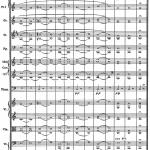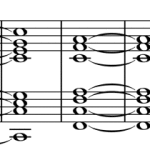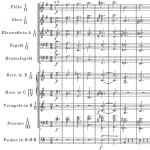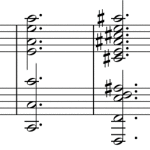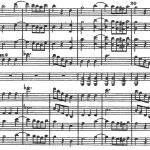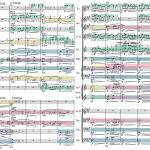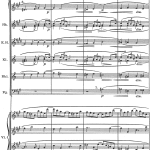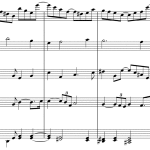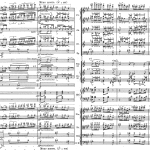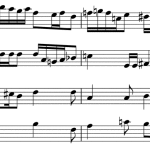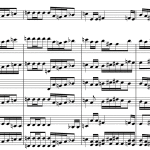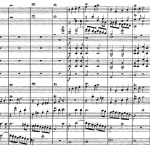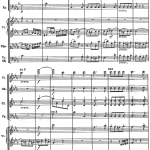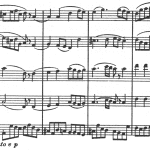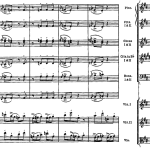Four-part chorale writing is still taught at conservatories all over the world as a representative template for “pure” traditional tonality. Although focusing on chord progressions rather than polyphony, the strict rules of voice leading continue to be a regular part of a traditional education in music theory. Considering the overwhelming influence of the four-part chorale as a fundamental model in classical music theory, one would reasonably expect to see orchestral music teem with examples of similar instrumental four-part writing: one instrument (or instrument group) = one voice. This, however, is not the case. An instructive case is the first movement of Symphonie fantastique, which ends with the quasi-chorale cited below (“religiosamente”). At first glance it appears to be a typical four-part chorale with the soprano part in the flute, 2nd oboe and 1st violins, and the bass part in the bassoon, cellos and double basses. But with regard to the alto and tenor part, Berlioz treats the remaining instruments freely in terms of tone color or other instrumental considerations, without paying any particular attention to voice leading.
Figure 114 · Berlioz, Symphonie fantastique, 1st movement, m. 516-528
Figure 115 · Berlioz, Symphonie fantastique, 1st movement, m. 516-528, reduction
Not even the rather more conservative Brahms follows the classical rules of voice leading in the otherwise homophonic, chorale-like opening of his 4th Symphony’s final movement.
Figure 116 · Brahms, Symphony No. 4, 4th movement, m. 1
Figure 117 · Brahms, Symphony No. 4, 4th movement, m. 1, reduction
Once again we see that idiomatic considerations may at times override or even transcend classical music theory. Something similar applies to polyphonic passages. Since its advent during the Middle Ages, polyphony has been associated with the notion of independent voices, each with its own individual identity and placement in the larger context. Once again it seems reasonable to expect one instrument or group of instruments to represent a single voice, appearing in its own well-defined position relative to the placement of the other voices and maintaining a particular tone color.
In the passage below, a counterpoint is added to the theme of the minuet. Here one may well expect the theme to assert its principal role, but thanks to the octave doubling of both parts, our perception of their relative importance in the texture (which is upper and which is lower?) resembles the kind of optical illusion that leaves the viewer with a choice between two equally valid interpretations.
Figure 118 · Mozart, Symphony No. 40, 3rd movement, m. 15
The Wagner example below shows how the tone color of individual voices is subject to continuous change.
Figure 119 · Wagner, Tristan und Isolde, Vorspiel, m. 43
Octave doublings and “split” orchestration – fundamental strategies found in all orchestral music – extend the notion of a “voice” to include unisono, i.e. something that behaves as one voice or line (as defined in the chapter on unisono and doubling). But in practice, the concept can be difficult to pin down. How many voices does the following example actually consist of?
Figure 120 · Wagner,Lohengrin, Vorspiel, m. 23
Below an attempted reduction.
Figure 121 · Wagner,Lohengrin, Vorspiel, m. 23, reduction
The independence of the three lower parts is unclear, however, as they appear rather more like one voice in three different versions.
Similar evidence for this broad definition of the term “voice” can be found in the music of Max Reger, a decidedly polyphonic composer.
Figure 122 · Reger,Variationen und Fuge über ein Thema von Mozart, fugue, number 29, m. 5
Admitting certain liberties, this passage may be reduced to four-part writing as shown below.
But the alto part occurs in a number of different versions.
From here, it is a short step to the partially doubled or heterophonic lines characteristic of Richard Strauss (c.f. figure 86, figure 87 and figure 88).
Orchestral polyphony frequently seems to involve a certain dissolution of voice identity, since contrapuntal movements or passages require more comprehensive and far more individual models than those offered by the restrictions of classical polyphony.
During the classical period, certain instruments (notably natural horns, natural trumpets and kettledrums) were forced to play a more rudimentary role in polyphonic passages due to their limited compass. Below the famous fugato from the finale of Mozart’s last symphony.
Figure 125 · Mozart, Symphony No. 41, 4th movement, m. 384
In the following example, however, no instrumental limitation explains the absence of wind doublings in the polyphony of the strings. Instead, Beethoven pits the color of the woodwinds against that of the strings.
Figure 126 · Beethoven, Symphony No. 3 (“Eroica”), 4th movement, m. 138
By using segment analysis instead of the more customary counting of voices, we see that the following example is composed of three segments, one of which consists of a counterpoint/accompaniment in the flutes.
Figure 127 · Mendelssohn, Symphony No. 4, 2nd movement, m. 12
In the following passage from the closing fugue of Benjamin Britten’s The Young Person’s Guide to the Orchestra, segment analysis is capable of revealing far more about the structural composition of the passage than a hunt for individual polyphonic voices.
Figure 128 · Britten, The Young Person’s Guide to the Orchestra, fugue, letter E (opens in a tab)
The 2nd violins imitate the 1st violins’ fugue theme, accompanied by a counterpoint in the woodwinds that is doubled in thirds by flutes and oboes, combined with an inversion of the theme in clarinets and bassoons. At letter F, the individual voices in the strings return to “normal,” now accompanied by full chords in the woodwinds.
· · ·
Next · Chapter 9 Dynamics and Balance
